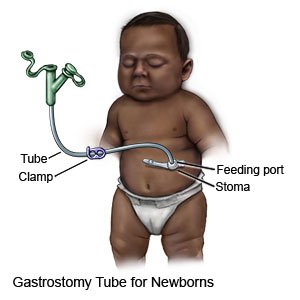Gastrostomy Care for Newborns
Medically reviewed by Drugs.com. Last updated on Apr 6, 2025.
What is a gastrostomy tube?
A gastrostomy tube, or G-tube, is placed into your baby's stomach through an opening in his or her abdomen called a stoma. A G-tube may be used to give your baby food or medicine. It may also be used to let air or liquid out of his or her stomach. Your baby may need a G-tube if he or she has trouble swallowing, eating, or keeping food down.
 |
How do I care for my baby's G-tube?
- Clean your baby's tube before and after you feed him or her. Always follow instructions about how much water to use.
- If your baby's tube has a balloon tip, make sure there is enough air inside it. Ask how much air should be inside the balloon.
- Replace the external tube every 2 weeks if directed to do so. Your baby's healthcare provider will show you how to replace the tube. Or, it may need to be replaced at the healthcare provider's office.
How do I care for the skin around my baby's G-tube?
- Clean your baby's tube site with soap and warm water. You may clean the skin around the tube while you give your baby a bath.
- Gently turn the tube as directed. This may help relieve the pressure on your baby's skin and prevent an infection. It may also help keep the tip of the tube in place. Ask when and how often to turn the tube.
- Use bandages to keep the skin around the tube dry. Ask about the best bandages to use on your baby's skin.
Drugs used to treat this and similar conditions
Phazyme
Phazyme is used for endoscopy or radiology premedication, functional gastric disorder, gas ...
Ozempic
Learn about Ozempic (semaglutide) for type 2 diabetes treatment, weight management, cardiovascular ...
Alka-Seltzer Anti-Gas
Alka-Seltzer Anti-Gas is used for endoscopy or radiology premedication, functional gastric ...
Maalox Anti-Gas
Maalox Anti-Gas is used for endoscopy or radiology premedication, functional gastric disorder, gas ...
Aluminum hydroxide/magnesium hydroxide/simethicone
Aluminum hydroxide/magnesium hydroxide/simethicone systemic is used for gas, GERD, hiatal hernia ...
How can I help prevent problems with my baby's G-tube?
- Check your baby's skin for redness or swelling at the tube site with each feeding.
- Keep your baby's skin clean and dry around the tube.
- Put the tube under your baby's clothes so it will not get pulled out.
- Follow directions for the proper care of your baby's tube.
- Check the marks on your baby's tube to make sure it is in the right place.
- Check to see if there is milk or formula blocking the tube.
- Measure the length of the external tube from the stoma to the end. Ask how long this part of the tube should be and measure it every day. This will help you see if the tube has moved inside your baby's abdomen.
Why might my baby's G-tube need to be replaced or removed?
- The tube may be replaced between 6 and 12 weeks after the first placement.
- The tube has fallen out.
- The tube has moved inside your baby's abdomen.
- Your baby does not need the tube anymore.
When should I contact my baby's healthcare provider?
- Your baby has a fever or is more fussy than usual.
- The tube is blocked or does not work.
- Fluid is leaking from your baby's stoma.
- The tube has moved out of place.
- The skin around your baby's stoma is red, swollen, or draining pus.
- Your baby has diarrhea or is vomiting.
- You have questions or concerns about your baby's condition or care.
When should I seek immediate care or call 911?
- Your baby's tube falls out. Cover it with a bandage.
- Blood or pus is coming out of your baby's tube.
- Your baby has sudden trouble breathing.
- Your baby's abdomen feels bloated or hard.
- Your baby's skin is yellow.
Care Agreement
You have the right to help plan your baby's care. Learn about your baby's health condition and how it may be treated. Discuss treatment options with your baby's healthcare providers to decide what care you want for your baby. The above information is an educational aid only. It is not intended as medical advice for individual conditions or treatments. Talk to your doctor, nurse or pharmacist before following any medical regimen to see if it is safe and effective for you.© Copyright Merative 2025 Information is for End User's use only and may not be sold, redistributed or otherwise used for commercial purposes.
Further information
Always consult your healthcare provider to ensure the information displayed on this page applies to your personal circumstances.
